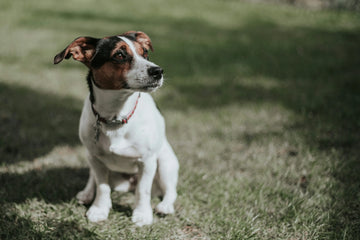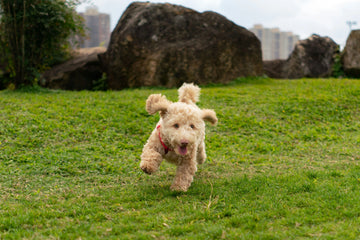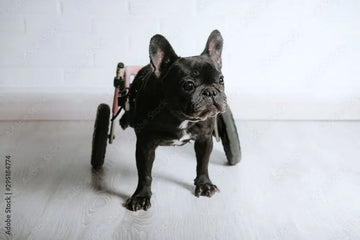When a dog suddenly starts walking unsteadily, hesitating on stairs, or crying out in pain, many owners feel helpless. These could be signs of a canine herniated disc—a condition that can sound frightening, but it’s not the end.
With early recognition, gentle care, and the right mobility support, many dogs recover and return to a happy, comfortable life.

I. What Is a Canine Herniated Disc?
A dog’s spine is made up of multiple vertebrae, each separated by a soft disc that cushions movement. When one of these discs becomes damaged, ruptures, or slips out of place, it can press on the spinal cord and cause pain or loss of mobility.
Common causes include:
-Sudden impact from jumping, falling, or rough play
-Age-related disc degeneration
-Genetic predisposition in breeds like Dachshunds, Corgis, and French Bulldogs
Typical symptoms:
-Back or neck pain; reluctance to be lifted
-Unsteady gait, hind-leg weakness, or loss of balance
-Difficulty climbing stairs or squatting to toilet
-In severe cases, paralysis or loss of bladder control
II. Diagnosing and Treating a Canine Herniated Disc
Treatment generally falls into two categories:
Conservative management
-Suitable for mild to moderate cases
-Includes pain relief, anti-inflammatory medication, crate rest, and light physiotherapy
Surgical treatment
-Recommended for severe compression or paralysis
-Removes or relieves the damaged disc material pressing on the spinal cord
Note: Even after surgery, long-term rehabilitation and physical support are vital to prevent recurrence.

III. Home Care and Recovery
The recovery period determines how well a dog can regain movement. A safe environment, gentle activity, and quality rest are all key to healing.
How owners can help:
Create a safe space
-Use non-slip mats to prevent slipping.
-Block access to stairs and furniture to avoid jumping.
Encourage mild, gradual activity
-Begin with short walks, slowly increasing duration.
-Hydrotherapy or gentle stretching under professional guidance can be beneficial.
Maintain a healthy weight
-Extra weight increases pressure on the spine.
Provide emotional support
-Recovery is slow—patience, praise, and affection make a big difference.
IV. Mobility Support for Dogs with a Herniated Disc
Many dogs experience instability or hind-leg weakness after injury. Using mobility aids can help restore confidence and movement.
Common supportive tools include:
-Dog Lift Harnesses – reduce spinal pressure and help lift the front or rear body safely.
-Dog Wheelchairs – ideal for severe hind-leg weakness or post-surgery recovery.
-Non-slip Socks or Boots – improve grip and prevent falls.
-Carpal Hyperextension Braces – stabilize front legs and prevent joint collapse.
Tip: Always choose mobility aids based on your dog’s size, injury type, and current ability.
V. Nutrition and Recovery Support
Good nutrition plays an important role in healing spinal and nerve tissue. The right diet helps maintain muscle mass and reduces inflammation.
Recommendations:
-High-protein, low-fat diet to promote muscle repair and prevent weight gain.
-Joint supplements such as glucosamine, chondroitin, and omega-3 to support cartilage and reduce inflammation.
-Adequate hydration to aid metabolism and prevent constipation.
Additional daily care:
-Gentle massage or warm compresses to relax muscles.
-Monitor urination and bowel movements; seek veterinary help if incontinence occurs.
-Schedule monthly checkups to track neurological improvement.

VI. Q&A: Common Questions About Canine Herniated Discs
Q1: Can a dog walk again after a herniated disc?
A: It depends on the severity. Many mild cases recover fully with rest and rehabilitation. Even dogs with severe injury or after surgery often regain mobility with consistent support and exercise.
Q2: Will my dog need a wheelchair forever?
A: Not necessarily. Many dogs use wheelchairs only during recovery. As strength returns, they may walk independently again.
Q3: How can I tell if my dog is in pain?
A: Shaking, whining, refusal to walk, or a hunched posture are all signs of pain—consult a vet immediately.
Q4: Can a canine herniated disc come back?
A: Yes. Breeds like Dachshunds and Corgis are prone to recurrence. Ongoing weight control and spinal support are essential to reduce the risk.
A canine herniated disc can take away a dog’s strength for a while, but not their spirit. With attentive care, the right equipment, and patience, recovery is possible. Every small step, tail wag, and moment of progress is worth celebrating.
Your love and persistence are not just treatment—they’re the reason your dog will walk, play, and trust again.
This article is for informational purposes only and is not a substitute for professional veterinary advice.




